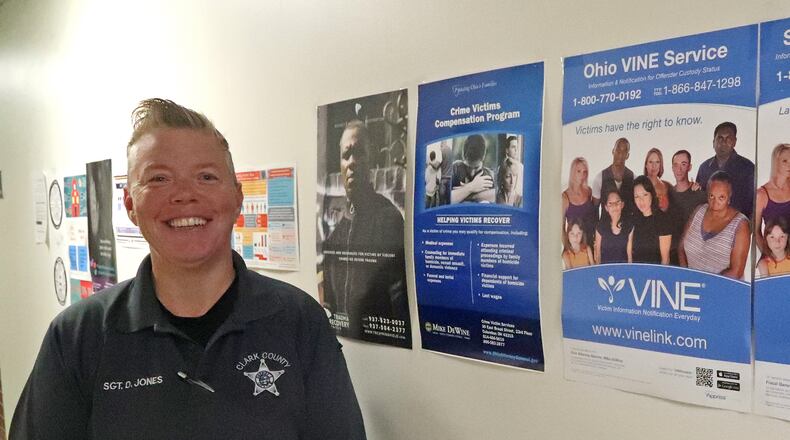“It was basically me fighting for my life every day,” Hullaby said.
Cases like this are increasingly being reported throughout the region. The number and severity of calls to local agencies in the Miami Valley that provide resources to victims of domestic violence skyrocketed as pandemic restrictions were lifted, and remain high.
Meanwhile, changes to federal policy reduced the largest funding source many of these agencies rely on in recent years, forcing them to cut staff or seek donations to meet this increased need. While new legislation was approved to help fix the reduction in funding, advocates say there is still a need for more federal funding, grants, donations and volunteers.
A survivor’s story
Hullaby first met her ex-partner in 2000, and she recalled how her first argument with him happened when she started studying at Wright State University. Their relationship took a difficult turn when she got pregnant with their son. Hullaby described how he became more controlling, as well as how he became more physically violent.
“I don’t eat pork, he forced me to eat pork. He forced me to smoke weed,” Hullaby said. “I got dragged by my hair.”
After she gave birth to their son, Hullaby said the controlling grew worse, explaining how he viewed her as “property.”
When children services became involved, she decided she would leave the relationship. She did so in May 2004, and by August 2004, she was able to get a protection order against him.
“I’m nobody’s victim. I am a survivor,” Hullaby said.
Hullaby’s story of surviving domestic violence, also called intimate partner violence in order to refer to both current and former spouses and dating partners, is an experience approximately one in four women and one in 10 men will deal with some version of in their lifetime, according to the U.S. Centers for Disease Control.
Approximately 35% of female survivors and over 11% of male survivors experience some form of physical injury due to intimate partner violence, according to the CDC. The CDC also estimates one in five homicide victims are killed by an intimate partner. In addition to experiencing impacts to physical and mental health, the cost of intimate partner violence over a survivor’s lifetime was estimated at $103,767 for women and $23,414 for men.
Barriers for domestic violence victims
When it comes to the barriers survivors face when leaving an abusive relationship, sometimes the obstacles make it more difficult to leave than to stay in the situation.
“People still say, ‘Well, why does she stay?’” said Jane Keiffer, executive director of the Artemis Center.
Survivors face financial, emotional, or societal barriers when it comes to leaving a partner in addition to potential threats of violence or coercion. The period after a survivor decides to leave a partner is one of the most violent times for the survivor. According to the Ohio Domestic Violence Network, of the fatalities related to domestic violence between July 1, 2020 and June 30, 2021, at least 27% of the cases involved the victim of intimate partner violence having ended, or in the process of ending, the relationship.
“Survivors stay because of fear, because of resources,” Keiffer said. “They stay because of children. They stay because they love their abuser, they think it’s going to get better, they want it to get better. We as a community really look at the survivor’s behavior versus looking at the abuser’s behavior, why does this person continue to be violent and how do we hold them accountable.”
Dynamics of domestic violence
Law enforcement has been engaging with local advocacy groups to help get survivors access to the resources they need more quickly. In doing so, law enforcement officers are getting more of an understanding of the survivor’s perspective.
“Working with advocacy has been a real eye-opener for me,” said Sgt. Denise Jones, who is part of the Clark County Sheriff’s Office’s intimate partner crime unit. “I know a lot of law enforcement officers see that as an adversarial system, but it’s so beneficial for us because ultimately that advocate is bridging that gap between us and the individuals we serve.”
Jones and a deputy work on all incidents of intimate partner violence reported to the sheriff’s office including stalking, domestic violence and strangulation incidents. They also follow up on cases brought to them by other law enforcement agencies.
Jones, who has been serving in this capacity since 2017, said through training and working with local advocates, her team can help people in abusive situations.
“Just understanding the dynamics of domestic violence and understanding why people can’t or won’t or don’t leave the situation immediately, or even in an extended period of time. There are so many dynamics behind domestic violence, and if people just understood that a little bit more, I think they would be less critical of people that don’t or can’t or won’t choose to leave at that first onset of the incident,” Jones said.
One of the local resources the sheriff’s office works with is Project Woman, an organization that is dedicated to ending domestic violence in Springfield. The shelter has served 487 people so far this year and is working to revive initiatives to continue conversations about domestic violence.
This October, the shelter will launch a new campaign as part of domestic violence awareness month to give a boost to its Partners Against Violence Everyday (PAVE) coalition. The campaign will urge people to take the PAVE pledge, a commitment to peaceful relationships and values.
Data from the Clark County Sheriff’s Office shows domestic violence calls to the sheriff’s office have dropped year over year for the last several years. However, Jones said the number of calls isn’t as important as helping people and encouraging them to reach out when they need help.
“It’s not always about call reduction, call reduction is good when I am getting a good outcome at that house,” she said. “So we don’t always look at a good metric as call reduction, we want to look at the metric as that person is finally out of that house and we were able to get them to services.”
Can domestic violence be prevented?
“Domestic violence is a learned behavior, so it really is our mission to break that cycle of violence,” Keiffer said. “We know that children who grow up in homes that witness violence, there’s a high correlation of repeating that violence.”
Not every child who grows up in an abusive household will become an abuser, she said, but it’s what they are used to and what they know.
“It really is important to help people understand healthy relationships,” Keiffer said. “We know one in four women will experience domestic violence in their lifetime.”
One in three teenagers also experience domestic violence, and Keiffer added it is important to teach teens what healthy relationships look like and how to get out of an abusive relationship safely.
Addressing domestic violence also means asking the perpetrators to change their behaviors.
“We need abusers to take accountability and be responsible for their behavior,” Keiffer said. “It’s really hard for most abusers to do that. If you think about abusers getting sent to treatment, it’s usually because it’s a court order, they’re not doing it on their own will. They’re doing it to avoid jail, so it’s really hard to stop that behavior.”
“I think it’s going to be a long epidemic in our country,” Keiffer said.
Staff writer Sydney Dawes contributed to this story
How to get help
The crisis line for Project Woman in Springfield, which serves both Clark and Champaign counties, is 800-634-9893.
The National Domestic Violence Hotline is 800-799-7233 and users can also text START to 88788.
The 24-hour Artemis Center Domestic Violence Hotline is 937-461-HELP (4357), and the Artemis Center web-based chat called Resource Connect is at www.artemiscenter.org/chatnow.
YWCA Dayton operates the only domestic violence shelters in Montgomery and Preble counties, as well as its own 24-hour hotline at 937-222-SAFE (7233).
The hotline for the Family Violence Prevention Center of Greene County is 937-426-2334, and the center’s text line is 937-347-5917.
Springfield fundraiser for Project Woman
A fundraiser for Project Woman called 2022 Diva Night Out will be held from 5:30 to 8 p.m. Oct. 27 at the Courtyard by Marriott at 100. S. Fountain Ave. Proceeds from the fundraiser go to support Project Woman’s emergency shelter services. To order tickets, go to projectwomanohio.org or email keckstrand@projectwomanohio.org.


